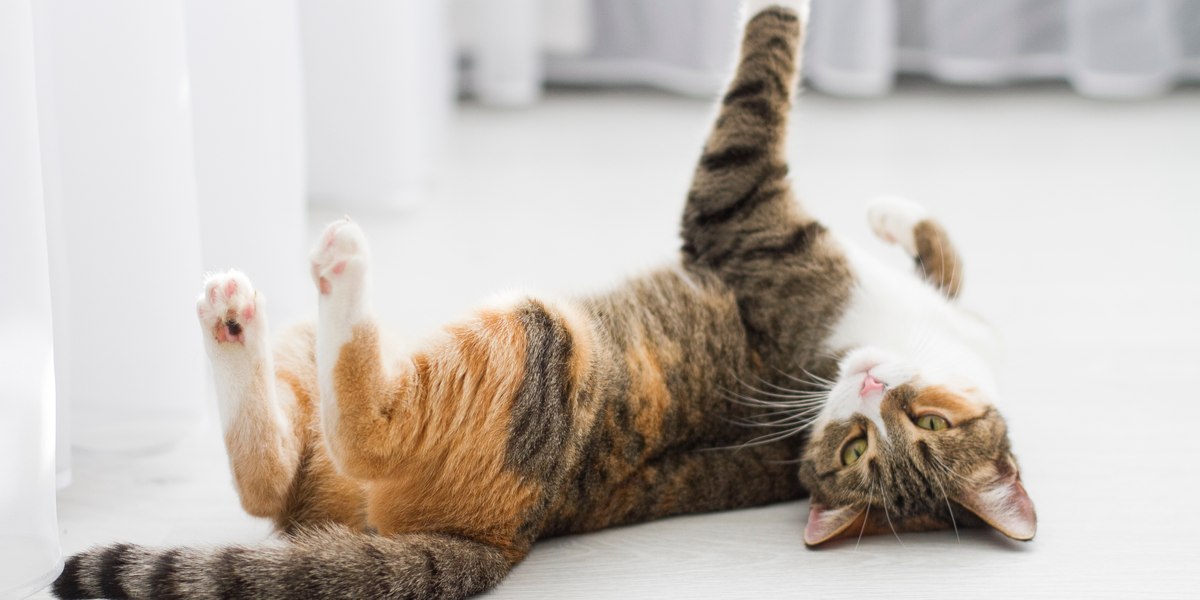
Female cats that have not been spayed will go into heat (estrus) for the first time when they hit puberty, around 4-6 months old. They will then have multiple heats each year, during the breeding season.
Cats are fertile during this part of the reproductive cycle and can become pregnant. They may also exhibit some odd, and often fairly dramatic behaviors. Cats in estrus may vocalize loudly, seek attention constantly, spray urine, and even try to escape the house! These signs can be troubling for pet owners.
In this guide, we’ll explore the stages of feline estrus, the signs that your cat may be in heat, and what you can do.
Phases of Estrous Cycle in Cats
A cat’s estrus (reproductive) cycle, also called a heat cycle, lasts on 14-21 days on average. It occurs in four stages:
Proestrus
This is a brief stage (1-2 days) which precedes estrus. The female cat may be attractive to males, but is not yet fertile or willing to mate.
Estrus
This is the fertile period of the cycle, where the female is ready and receptive to mating, and can become pregnant if mated. It lasts for 3–14 days. During this stage, your cat may show various signs, such as rolling around on the floor, showing more affection, and vocalizing. She may spray around the house or her territory to let male cats know she is ready to mate. Male cats can smell a female in heat from a mile away.
Interestrus or Diestrus
If the cat isn’t mated, the interestrus period between heat cycles lasts 2-3 weeks.
If the cat is mated and ovulates, she will enter the diestrus phase. The fertilized eggs become embryos and implant in the uterus. Pregnancy lasts 62–64 days.
Anestrus
This is the stage in which the queen is reproductively dormant: she doesn’t experience any heat cycles. Cats are seasonal breeders, and don’t cycle during the colder months with shorter day lengths. She won’t go into heat during this time, and can’t become pregnant.
8 Signs Your Cat Is in Heat
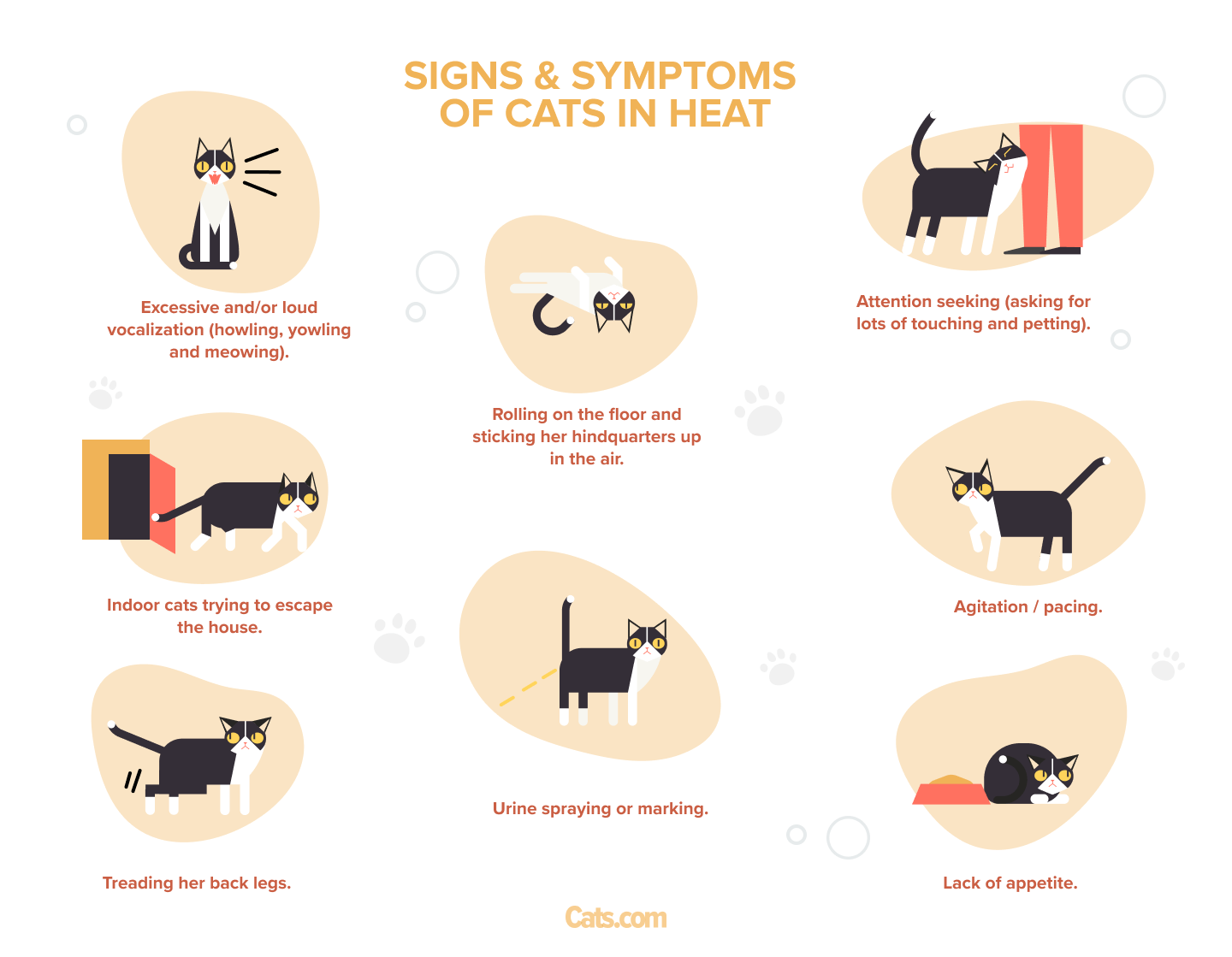
In cats, the physical signs of estrus are hard to spot. Cats don’t bleed when they’re in heat. The more obvious clues are behavioral, and can be quite dramatic! A cat will experience her first estrous cycle when she reaches sexual maturity. The exact age at which a cat goes into heat for the first time varies. It is generally around six months of age but can be as early as four months.
Signs that your cat is in heat include:
- Excessive and/or loud vocalization (howling, yowling, and meowing)
- Rolling on the floor and sticking her hindquarters up in the air
- Attention seeking (asking for lots of touching and petting)
- Indoor cats trying to escape the house
- Agitation or pacing
- Treading her back legs
- Urine spraying or marking
- Decreased appetite
What to Do When Your Cat Is in Heat
Cats in heat can show persistent, dramatic, and potentially concerning behaviors. You may worry that your cat is in pain due to their yowling and agitation, but these are all part of a normal heat cycle.
It can be hard to know what to do to help. Some ways to try to deal with a cat in heat include:
- Distracting with play, a new toy, or a treat
- Offering her catnip
- Calming aids
Unfortunately, it’s nearly impossible to stop a cat in heat from meowing, pacing, rolling around, and raising her rear into the air. You may have to simply wait it out.
Once your cat’s out of heat, spaying her will keep her from ever going into heat again.
Should You Spay Your Cat?
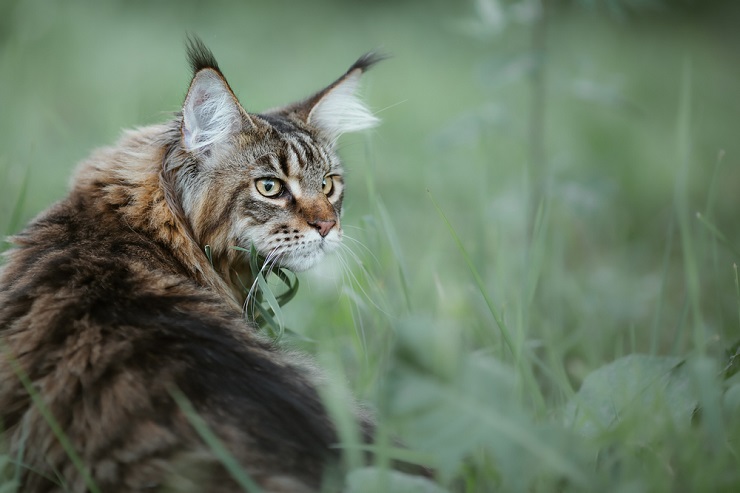
Cats in heat will constantly try and escape out to find a mate, which can be dangerous.
You can stop your cat from coming into heat and from becoming pregnant by having her spayed. This is a simple operation performed by a veterinarian, where the cat’s reproductive organs are removed via a small incision.
Intact female cats undergo multiple heats each year. During these times, they vocalize loudly, roll around, urinate on things, and constantly try to escape. If they do manage to get out, this can be dangerous, as they may roam far from home to find a mate. Pregnancy in very young cats can also be harmful to their growing bodies—not to mention the responsibility that comes with a litter of kittens!
Spaying or neutering is recommended for all cats. Cats may have 2-8 kittens per litter and can have between 2–5 litters per season. That means just one cat could potentially have hundreds of kittens in their lifetime! In addition to all the behavioral advantages, spaying also eliminates the risk of uterine and ovarian cancers and reduces the risk of other medical conditions, such as uterine infections.
Frequently Asked Questions
When do cats go into heat?
Cats usually have their first estrus around 4-6 months of age. They are seasonal breeders, mostly cycling in the lighter, warmer months of the year - March - September is the peak time in the Northern Hemisphere - although they can cycle all year round.
How often do cats go into heat?
Cats are seasonally polyestrous, which means they can go into heat many times throughout the breeding season. Since feline pregnancy (gestation) is so short, cats can have more than one litter of kittens in a breeding season. Typically, a cat may go through numerous heat cycles in one season. In some geographic regions, the feline breeding season may be year-round.
Do cats bleed when in heat?
No, cats don’t bleed during estrus. If you notice blood from your cat’s vulva, seek advice from a veterinarian. The signs of estrus in cats are mostly behavioral, such as vocalizing and attention seeking, rather than physical.
Do cats spray when in heat?
Yes, female cats may spray urine when they are in heat. This is an attempt to attract a mate, and can go alongside other changes such as loud vocalizations and rolling around the floor in strange positions.
How long does a cat stay in heat?
The length of a feline heat can vary from just a few days to a few weeks, but the average time in estrus is around a week.
 Updated by
Updated by
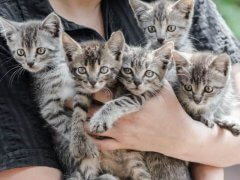

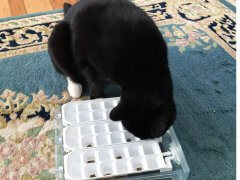
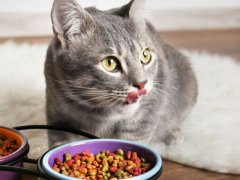
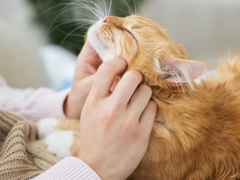
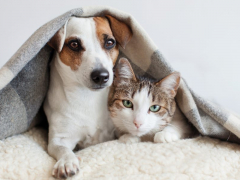
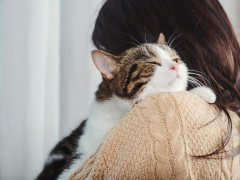
fluffy does not like to climb or jump, always sleeping and is not playful is this normal 11 months and is in heat
Lethargy like that is not a typical part of being in heat. I would advise bringing your cat to see a vet and make sure there’s nothing wrong.
I feed stray cats. My dog hates cats but this cat adopted my dog, so she has become part of the family. If
Angel doesnt like what the cat is doing, she lets her know and all seems to be ok again. I thought for sure that
the kitty must be in heat since the tomcats are around her constantly when she is outside. I don’t know if I can keep her away from them for 21 days. She was talking so loud IN THE EVENING AND ALL NIGHT LONG. i COULDN’T UNDERSTAND THAT UNTIL i READ YOUR ARTICLE. hOW CAN i NAME HER? I just call her kitty kitty and she seems to know what I’m asking of her. Great article. She seems to not be interested in my dog or myself now. Is that part of the heat process? How will I know when she is out of heat? I can’t get her spade until July 20th,
Hello Lynn, thanks for the comment! You can tell that your cat is in a (brief) period of non-estrus when she stops yowling, meowing, and acting strange. Becoming less clingy and affectionate can also be indicative that she’s out of heat. You’re right that keeping her away from the male cats will be difficult, and if you don’t want your cat to get pregnant, I would recommend taking her in to get spayed. Kitty Kitty is a fine name, and there’s no rush to find another one. I’m sure the perfect name will come to you.
“Needles” is an appropriate name for any cat. My hands, arms and legs look like a road map!
Just one thing. Human females – that is us – do not bleed when we are fertile. On the contrary: menstruation is a totally safe period. It is right in between the menstruations, that we ovulate and can become pregnant. No bleeding then.
Helena, thank you so much for pointing this out. I’ve corrected the content.
I have a female cat that my guy friend brought here from states away. When he left he also left her and her newborn kittens with me, in my already multi cat household. Needless to say, there have been, and still are, many conflicts. That brings me to my question…how do I know that she is in interestrus and safe to be around her 2, now 8 month old, male kittens?
Hi Rita, thanks for the comment. Cats will remain in estrus for a week or two every 3-4 weeks until they have been bred, and trying to keep her apart from her sons only during this time is not the most effective way to prevent pregnancy. Generally, it’s recommended to keep non-“fixed” male and female cats separated all the time in this case. Having her spayed is the most reliable way to prevent pregnancy.
A starving 6-month old kitten recently showed up at our rental house, and we’ve been getting her healthy again. The vet thought we should wait two weeks to get her spayed because of this. But now she’s in heat. I’ve seen some articles say that you should wait a month after the heat cycle to get a cat spayed, which would mean we have to wait for several months if the heat cycle returns every two to three weeks through the spring and summer. We can’t keep her from the local males for that long. So I’m hoping that when she’s out of the noisy and weird estrus phase and in her interestrus phase, it’s safe to get her spayed? Or we should wait a week after her estrus phase? If we wait two weeks afterwards, don’t we risk her going into the estrus phase again? We also plan to fly her home to the U.S. in mid-February, as there are so many cats here fighting for food (island of Cyprus) and we’re worried she’ll starve again or get hurt. All the shelters and foster houses are more than full! She has to be spayed before we can do this. We’ll be gone for two months and can’t take care of her from mid-Feb to mid-April, so time is of the essence for her spaying. Please let me know what you think. I certainly don’t want to put her in danger.
Hey Michelle, this question is a bit out of my depth—I’d advise copying and pasting this in the All About Cats community forum so you can get an answer from a qualified vet. Thank you!
Thanks!
You’re welcome. Hope you get the information you need!
Hi Mallory, My 8month old is in heat for the 2nd noticeable time, showing all the above signs, loud vocalizations for hours etc.
Here is my question, the 1st noticable cycle she went around head butting everything, rubbing her face and head on anything and everything hard, like corners of walls, table legs etc.. A small bump appeared on her head, was not sure if this was a result of her hitting things, or a hormonal thing causing her head to become itchy, anyway the period passed and the small bump healed in a week or 2, leaving a very tiny bald spot, the hair grew back again and all was normal.
Until this time around that is, she’s at it again smashing into things with her head, this time there are 3 small lumps or bumps.
One o top of her nose in between her eyes the other 2 top of her head, I must note these bumps are very small and are not visible but u can feel them with your finger. So is it a part of hormonal process to get itchy lumps on heads, or is it a result of her head butting things at every opportunity? I will take her to a vet after her cycle has ceased, and am considering getting her spayed, as she seems in so much turmoil during this period.
Thanks for any advice.
Hi Selina, apologies for the late reply! Hope you and your cat are doing well. From what I understand, this doesn’t seem to be a hormonal response, and it seems much more likely that she’s hurting herself a little bit by doing all of that bumping and butting. Getting her spayed should alleviate all of this, but I would recommend asking the vet as well to make sure there’s no other cause. Take care!
I HAVE A QUESTIONABOUT MY FEMALE CAT’S “CHINA” AND “KALI” THEY ARE OF THE SAME LITTER ABOUT 1 YEAR OLD NOW THEY’VE OVIOUSLY BEEN TOGETHER SINCE BIRTH I SEEKED GOOD HOMES ONLY FOR THE REST OF THE LITTER OF 6 TOTAL AND WHEN IT CAME DOWN TO THEM I PROLONGED FINDING THEM HOMES AND I REALIZED THEY ARE SO CLOSE I COULD NOT SEPARATE THEM SO HERE WE ARE 1 YR LATER AND CHINA HAS CAME INTO HEAT 2 TIMES NOW AND KALI HAS NOT COME INTO HEAT YET. I KNOW FOR SURE KALI IS NOT A CALVIN FOR A FACT SO MY QUESTION IS THAT NORMAL FOR 2 FEMALES BEING AROUND EACH OTHER TO ONLY ONE GOING INTO HEAT BECAUSE SOME SORT OF FEMALE THING. ANYONE KNOW WHY THIS IS? IM VERY CURIOUS TO KNOW. THANKS IN ADVANCE FOR YOUR ANSWER.
Hmm, fascinating question. From what I understand, being around another female cat will not inhibit a cat from going into heat. There are a few possibilities here. For one, Kali may have some health issues that are preventing her from going into heat. Secondly, perhaps her symptoms of having gone into heat are more subtle than China’s. The other possibilities are that Kali is actually male or was spayed at some point before you adopted them. I know these other considerations may seem rude, but I have to suggest them—please forgive that! Hope you’re able to find an answer soon!
HOW LONG AFTER GIVING BIRTH WILL A CAT GO INTO HEAT AGAIN?
About 8 weeks later. 🙂
Thanks for a great article… I am an ardent cat lover and had many in my eighty years… but the last few months have been difficult with our spayed female. She is 7 years old and was spayed at around 6-7 weeks but a very strange thing happened last year. She had been bothered by a few cats at times and we wondered if she was putting out hormones at times, then the strangest thing ever last October, we found what looked like a small kidney on our floor one morning and eventually decided that it was a cat foetus!! How was this possible?? We have now moved to a different area in Spain and for the last 1-2 months our cat has been attacked many times by a local ginger tom, and just been wondering if this tom has been trying to mount her as the last time she had a very painful back leg /end area, problem walking and I couldn’t even touch her there, she hissed and spat at me, she was in quite a poorly state for 4/5 days… What do you think? Any suggestions?
That is incredibly strange…can you talk with a vet to confirm that she’s actually spayed? Wishing you all the best.
If a cat goes thru several bouts of heat before spaying, it this harmful to her?
Hi Sandra, this is a great question to ask your veterinarian. Generally speaking, however, it’s safe to have a cat spayed at least a week or two after they’ve completed a heat cycle. Spaying while the cat is in heat could increase the risk for excessive bleeding.